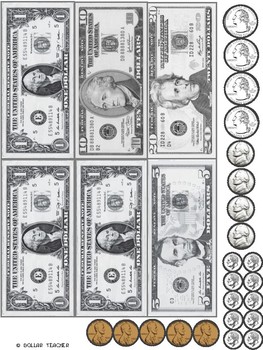★Printable Money ★ Paper Saver ★ Ink Saver ★ Realistic
Light Up the Classroom by Mrs Light
68 Followers
Grade Levels
K - 6th
Subjects
Resource Type
Standards
CCSSK.CC.B.4
CCSS2.MD.C.8
CCSS1.NBT.B.2a
CCSS1.OA.C.5
CCSS1.OA.C.6
Formats Included
- PDF
Pages
1 page
Light Up the Classroom by Mrs Light
68 Followers
What educators are saying
We are using the money to reward the kids for jobs well done and then they get to shop at our Title one store.
I used the dollar bills to laminate and give them to students to move their pieces on a big game board on the wall which in turn will help them receive a party during Christmas and before school got out.
Description
Save paper with my printable money resource! Cut out the money ahead of time or let your students do the work! All of the graphics are fit onto one sheet of paper, so you only have to print one sheet per student.
✔ One sheet of paper per student
✔ 3 One Dollar Bills
✔ 1 Five Dollar Bill
✔ 1 Ten Dollar Bill
✔ 1 Twenty Dollar Bill
✔ 4 Quarters
✔ 10 Dimes
✔ 4 Nickels
✔ 5 Pennies
File info
✔ Delivered as a PDF
Total Pages
1 page
Answer Key
Does not apply
Teaching Duration
N/A
Report this resource to TPT
Reported resources will be reviewed by our team. Report this resource to let us know if this resource violates TPT’s content guidelines.
Standards
to see state-specific standards (only available in the US).
CCSSK.CC.B.4
Understand the relationship between numbers and quantities; connect counting to cardinality.
CCSS2.MD.C.8
Solve word problems involving dollar bills, quarters, dimes, nickels, and pennies, using $ and ¢ symbols appropriately. Example: If you have 2 dimes and 3 pennies, how many cents do you have?
CCSS1.NBT.B.2a
10 can be thought of as a bundle of ten ones - called a “ten.”
CCSS1.OA.C.5
Relate counting to addition and subtraction (e.g., by counting on 2 to add 2).
CCSS1.OA.C.6
Add and subtract within 20, demonstrating fluency for addition and subtraction within 10. Use strategies such as counting on; making ten (e.g., 8 + 6 = 8 + 2 + 4 = 10 + 4 = 14); decomposing a number leading to a ten (e.g., 13 - 4 = 13 - 3 - 1 = 10 - 1 = 9); using the relationship between addition and subtraction (e.g., knowing that 8 + 4 = 12, one knows 12 - 8 = 4); and creating equivalent but easier or known sums (e.g., adding 6 + 7 by creating the known equivalent 6 + 6 + 1 = 12 + 1 = 13).


